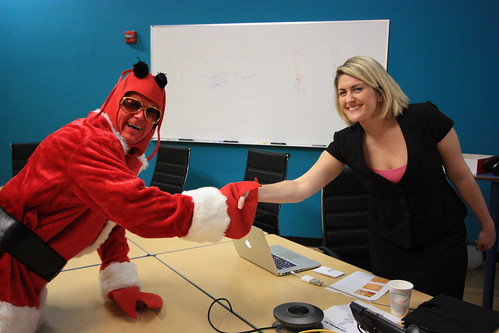 |
| Probably not the ideal teaching candidate! |
This post is part 2 in the series Interviewing and Hiring. Last time we looked at applicant screening and candidate selection (If you missed part 1 click through here). Today we'll look at the interview process.
I like to break the interview process into three distinct steps or processes. Preinterview, interview, and post-interview. Each step in the process is equally important - fail to develop quality interview questions and you'll lack insight into your candidates. Fail to check referrences and you'll get burned post hire. So take time to develop each step. Keep in mind that recruiting, hiring, and retaining a quality instructional staff is one of the principal's most important jobs.
Pre-Interview
- Sit down with the job description, the anticipated teaching schedule, and the subject or grade level curriculum to develop interview questions. Your questions should be as job specific as possible. If you're looking for an Algebra teacher gear your questions toward Algebra rather than mathematics in general. If you're looking for a primary teacher ask questions about teaching young children rather than teaching intermediate children.
- Make sure all of your questions relate to the position for which you are hiring. Do not ask questions regarding age, race, color, gender, pregnancy, religion, national origin, martial status, or disability. Sometimes even a seemingly innocent question or comment can come back to bite you on the rump. Let's say you ask an obviously pregnant candidate a question like, "Congratulations on the baby, when are you due?" You think the question shows a personal interest in the candidate, the candidate, who doesn't get the job, thinks you discriminated against her because she's pregnant.
- An aside for my colleagues at the secondary level - I know you need coaches but I think that you should select teachers first and coaches second. It's okay to ask something like, "We have a lot of student sports, activities, and interest groups here ... would you be willing to help out or apply for coaching positions for which you are qualified?" And for heaven's sake don't ask every Social Studies teacher if he wants to coach football. I can't tell you how many times I had to respond to that question!
- Do call on candidates to demonstrate proficiency. Have a computer with web access available so candidates can show your their professional digital persona. If they bring a portfolio, take a look at it, and let them walk you through its contents.
- Don't shy away from tough questions. Here's a few that I like, "How do you build student engagement?" "What does diversity look like in your classroom?" "How do you build on and enhance diversity?" "How do you respond when a student doesn't get it?" "How do you support struggling learners?" "How do you support advanced learners?"
- Ask, "Can you show me what that looks like either in your portfolio, your online work, or by sharing an example?"
- Print all of your questions on a response/scoring sheet and print copies for your interview panel. Leave room for panel members to record notes and reactions.
- Assemble your interview panel. Include department or grade level chairs, assistant principals, curriculum specialists and other experts. I'm not inclined to include parents and students on interview panels but this is a growing trend.
- Don't rush the interview, allow ample time for each candidate to share his vision and experience.
- Stick to your predetermined questions but feel free to ask reasonable follow-up or clarifying questions.
- Let the candidate do most of the talking.
- Don't argue with or prod the candidates for answers. If an answer is substandard, note it on your response sheet and move on.
- Before ending the interview thank the candidate for their time and let them know the process you will employ for making a final selection.
- Immediately following the last interview have the panel rank their top candidates and compare your rankings. If a panel member has a favorite, allow them to advocate for that candidate. Try to reach consensus but reserve the right, as principal, to make the final decision. Make all decisions contingent on a favorable reference check.
- Check references. Don't rely on the references submitted to a web-based applicant system. I once read an applicant's reference that was sent to the same email address the applicant used to register. Pick up the phone and call.
- Be cautious about looking at a candidates personal social media pages as there are some major pit falls to avoid. (The pit falls would fill an entire post so let me know if you'd like additional information.)
- Select your candidate and follow district procedures for making an offer.
- Send a letter or email to those candidates not selected. (Make sure #1 accepts the offer before your send rejection letters to #2 and #3!)
- Keep all information related to the interviewing and hiring process for three years.
No comments:
Post a Comment